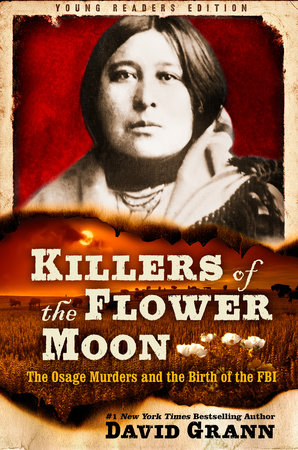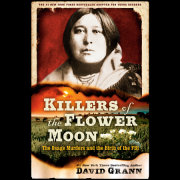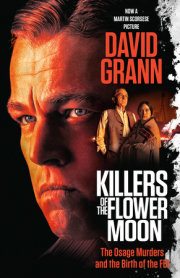IN APRIL, MILLIONS OF TINY FLOWERS SPREAD OVER THE blackjack hills and vast prairies in the Osage territory of Oklahoma. There are Johnny-jump-ups and spring beauties and little bluets. The Osage writer John Joseph Mathews said that the galaxy of petals makes it look as if the “gods had left confetti.” In May, when coyotes howl beneath an unnervingly large moon, taller plants, such as spiderworts and black-eyed Susans, begin to creep over the tinier blooms, stealing their light and water. The necks of the smaller flowers break and their petals flutter away, and before long they are buried underground. This is why the Osage Indians refer to May as the time of the flower-killing moon.
On May 24, 1921, Mollie Burkhart, a resident of the Osage settlement town of Gray Horse, Oklahoma, began to fear that something had happened to one of her three sisters, Anna Brown. Thirty-four, and less than a year older than Mollie, Anna had disappeared three days earlier. She had often gone on “sprees,” as her family called them: dancing and drinking with friends until dawn. But this time, one night had passed and then another, and Anna had not shown up on Mollie’s front stoop as she usually did. When Anna came inside, she liked to slip off her shoes, and Mollie missed the comforting sound of her moving, unhurried, through the house. Instead, there was a silence as still as the plains.
Mollie had already lost her sister Minnie nearly three years earlier. Minnie’s death had come with shocking speed, and though doctors had named it a “peculiar wasting illness,” Mollie had her doubts. Minnie had been only twenty-seven and had always been in perfect health.
Like their parents, Mollie and her sisters had their names inscribed on the Osage Roll, which meant that they were among the registered members of the tribe. It also meant that they were worth a fortune. In the early 1870s, the Osage had been driven from their lands in Kansas onto a rocky, presumably worthless reservation in northeastern Oklahoma. Decades later, they discovered that this land was sitting above some of the largest oil deposits in the United States. And to get that oil, prospectors had to pay the Osage.
In the early twentieth century, each person on the tribal roll began receiving a quarterly check. The amount was initially for only a few dollars, but over time, as more oil was tapped, the payments grew into the hundreds, then the thousands. And virtually every year, they received more and more, until the tribe members had collectively accumulated millions and millions of dollars. (In 1923 alone, the tribe took in more than $30 million, which would be worth more than $400 million today.) The Osage were considered the wealthiest people per capita in the world. “Lo and behold!” the New York magazine Outlook exclaimed. “The Indian, instead of starving to death . . . enjoys a steady income that turns bankers green with envy.”
The public had become transfixed by the tribe’s prosperity, which contradicted many of the images of American Indians that could be traced back to the brutal first contact with whites—the original sin from which the country was born. Readers were fascinated by stories about the Osage’s brick mansions and chandeliers, their diamond rings and fur coats and chauffeured cars. One writer marveled at Osage girls who attended the best boarding schools and wore sumptuous French clothing.
At the same time, reporters seized upon any signs of the traditional Osage way of life, which seemed to stir in the public’s mind visions of “wild” Indians. One article noted a “circle of expensive automobiles surrounding an open campfire, where the bronzed and brightly blanketed owners are cooking meat in the primitive style.” Another documented a party of Osage arriving at a ceremony for their dances in a private airplane.
Gray Horse was one of the reservation’s oldest settlements. These outposts—including Fairfax, a larger town of nearly fifteen hundred people, and Pawhuska, the Osage capital, with a population of more than six thousand—seemed like fevered visions. The streets clamored with cowboys, fortune seekers, bootleggers, soothsayers, medicine men, outlaws, U.S. marshals, New York financiers, and oil magnates. Automobiles sped along paved horse trails, the smell of fuel overwhelming the scent of the prairies. There were restaurants, advertised as cafés, and opera houses and polo grounds.
Although Mollie didn’t spend as lavishly as some of her neighbors did, she had built a beautiful, rambling wooden house in Gray Horse near her family’s old lodge of lashed poles, woven mats, and bark. She owned several cars and had a staff of servants. The servants on the reservation were often Black or Mexican, and in the early 1920s a visitor to the reservation expressed contempt at the sight of “even whites” performing “all the menial tasks about the house to which no Osage will stoop.”
Mollie was one of the last people to see Anna before she vanished. That day, May 21, Mollie had risen close to dawn, a habit ingrained from when her father used to pray every morning to the sun. She was accustomed to the chorus of meadowlarks and sandpipers and prairie chickens, now overlaid with the pock-pocking of drills pounding the earth. Unlike many of her friends, who shunned Osage clothing, Mollie wrapped a traditional blanket around her shoulders. She also didn’t cut her hair in a flapper bob, but let her long black hair flow over her back, revealing her striking face, with its high cheekbones and big brown eyes.
Her husband, Ernest Burkhart, rose with her. A twenty-eight-year-old white man, he looked like an extra in a Western picture show: short brown hair, slate-blue eyes, square chin. Only his nose disturbed the portrait; it looked as if it had taken a barroom punch or two. Growing up in Texas, the son of a poor cotton farmer, he’d been enchanted by tales of the Osage Hills—that last American frontier where “cowboys and Indians” were said to still roam. In 1912, at nineteen, he’d packed a bag, like Huck Finn lighting out for the Territory, and gone to live with his uncle, a domineering cattleman named William K. Hale, in Fairfax.
“He was not the kind of a man to ask you to do something—he told you,” Ernest once said of Hale, who became his surrogate father. Though Ernest mostly ran errands for Hale, he sometimes worked as a taxi driver, which is how he met Mollie, chauffeuring her around town.
Ernest had a tendency to drink liquor and play stud poker with shady men. Beneath his roughness, though, there seemed to be a tenderness and a trace of insecurity about him, and Mollie fell in love with him. Born a speaker of Osage, she had studied English in school. But Ernest still made the effort to learn her native language until he could talk with her in it. Mollie suffered from diabetes, and he cared for her when her joints ached and her stomach burned with hunger. After he heard that another man had affections for her, he muttered that he couldn’t live without her.
It wasn’t easy for them to marry. Ernest’s roughneck friends ridiculed him for wanting to marry an Osage woman. And though Mollie’s three sisters had wed white men, she felt a responsibility to have an arranged Osage marriage, the way her parents had. Still, Mollie, whose family practiced a mixture of Osage and Catholic beliefs, couldn’t understand why God would let her find love only to then take it away from her. So in 1917, she and Ernest exchanged rings, vowing to love each other till eternity.
By May 1921, they had a daughter, Elizabeth, who was two years old, and a son, James, who was eight months old and nicknamed Cowboy. Mollie also tended to her aging mother, Lizzie, who had moved into the house after Mollie’s father passed away. Lizzie once feared that Mollie would die young, because of her diabetes, and she begged her other children to take care of her. In truth, Mollie was the one who looked after all of them.
May 21 was supposed to be a delightful day for Mollie. She liked to entertain guests and was hosting a small luncheon. After getting dressed, she fed the children. Cowboy often had bad earaches and she’d comfort him till he felt better. Then she issued instructions to her servants as everyone in the house bustled about—except her mother, who’d fallen ill and stayed in bed. Mollie asked Ernest to call Anna and see if she’d come over to help tend to Lizzie for a change. Anna, as the oldest child in the family, held a special status in their mother’s eyes and was the one her mother spoiled.
When Ernest told Anna that her mama needed her, she promised to take a taxi straight there. She arrived shortly afterward, dressed in bright red shoes, a skirt, and a matching blanket. In her hand was an alligator purse. Before entering, she’d quickly combed her windblown hair and powdered her face. Mollie noticed, however, that Anna was drunk.
Mollie couldn’t hide her displeasure. Some of the guests had already arrived. Among them were two of Ernest’s brothers, Bryan and Horace Burkhart, who had been lured to Osage County by oil and often assisted Hale on his ranch. One of Ernest’s aunts, who spewed racist notions about American Indians, was also visiting, and the last thing Mollie needed was for Anna to cause a commotion.
Anna slipped off her shoes and began drinking whiskey. Mollie knew that Anna had been very troubled of late. She’d recently divorced her husband, a settler named Oda Brown, and since then had spent more and more time in the reservation’s boomtowns that had sprung up to house and entertain oil workers.
At Mollie’s house, Anna began to flirt with Ernest’s younger brother, Bryan, whom she’d sometimes dated. He was more brooding than Ernest and had yellow-flecked eyes and thinning hair, which he wore slicked back. A lawman who knew him described him as a troublemaker. When Bryan asked one of the servants at the luncheon if she’d go to a dance with him that night, Anna said that if he fooled around with another woman, she’d kill him.
Meanwhile, Ernest’s aunt was muttering, loud enough for all to hear, about how mortified she was that her nephew had married an American Indian. It was easy for Mollie to subtly strike back, because one of the servants attending to the aunt was white— a blunt reminder of the town’s social order.
Anna continued causing a ruckus. She fought with the guests, fought with her mother, fought with Mollie. “She was drinking and quarreling,” a servant later told authorities. “I couldn’t understand her language, but they were quarreling.” The servant added, “They had an awful time with Anna, and I was afraid.”
That evening, Mollie planned to look after her mother while Ernest took the guests into Fairfax, five miles to the northwest, to meet his uncle Hale and see a play. Bryan, who’d put on a cowboy hat, his catlike eyes peering out from under the brim, offered to drop Anna off at her house.
Before they left, Mollie washed Anna’s clothes, gave her some food to eat, and made sure that she’d sobered up enough that Mollie could glimpse Anna’s usual bright and charming self. They lingered together, making up and sharing a moment of calm. Then Anna said good-bye, a gold filling flashing through her smile.
Copyright © 2021 by David Grann. All rights reserved. No part of this excerpt may be reproduced or reprinted without permission in writing from the publisher.











